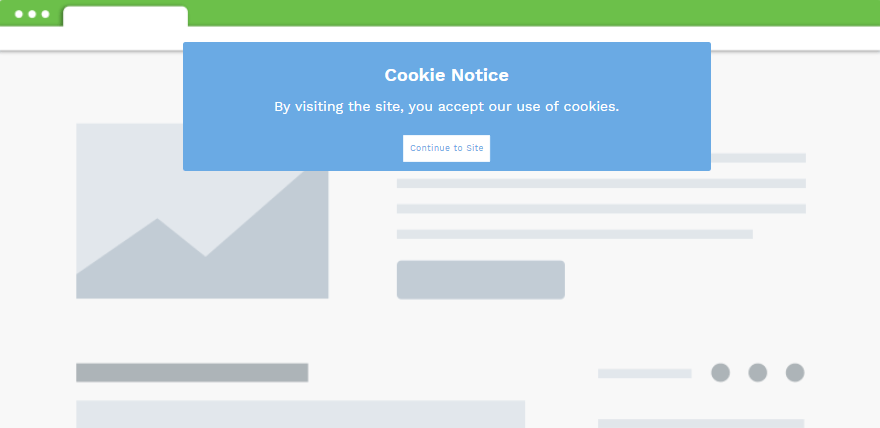
Knowledgebase Policy / Notice Management What is a Cookie Wall?
Articles
What is a Cookie Wall?
Last Updated: August 5, 2022
Cookie Wall
A Cookie Wall, also known as a tracking wall, requires users to ‘agree’ or ‘accept’ all cookies and trackers in order to use a website. Including processing a user’s personal data. This option doesn’t give the user an opportunity to reject all or part of the cookies and still utilize the website. Therefore, it’s referred to as the “take it or leave it” approach.
This ensures the website can activate all cookies and trackers to get as much data as possible, despite a user’s wishes. Although not always true, websites will utilize this approach when they fear giving users a choice to determine which cookies they allow, will break their website.
Example
Essentially, a cookie wall is a variation of a cookie banner or popup. However, only a cookie wall gives users no option to select or de-select certain categories of cookies. These can be third-party cookies that contain tracking information used by marketing and ad tech companies.
An example of a cookie wall is a notice-only banner below.

This cookie banner is displayed as such the only way to access the content on the website is to accept all the cookies. Cookie walls like this are prevalent on many news sites that people rely on for their current events and information.
How do Cookie Walls Work?
The majority of websites use first and third-party cookies. These cookies range from strictly necessary to the operation of a website to analytics cookies that use data to give insight into the performance of a website.
Cookie walls work when making consent a condition to accessing a website’s services and products. Alternatively, denying users entry unless they give full consent to all cookies. This leaves out any choice for the user, allowing some laws and countries to not consider this consent.
Are Cookie Walls Legal?
Not always. Depending on your regulators as well as the location of you and your users, cookie walls can be considered non-compliant. Learn about the specific data protection laws below.
EDPB & GDPR
On May 4th 2020, the European Data Protection Board (EDPB) updated guidelines around online consent to be compliant with the GDPR. One of the updated guidelines provided clarification on the validity of consent as provided by data subjects when interacting with cookie walls.
Two recommendations were provided:
- service providers cannot prevent data subjects from accessing a service on the basis that they do not consent; and
- ‘cookie walls’ are not permitted: access to services and functionalities must not be made conditional on the consent of users to the placement of cookies or similar technologies on their terminal equipment.
Most importantly, the Guidelines provide that consent within cookie walls cannot be considered as freely given. Additionally, scrolling or swiping through a webpage, or similar actions do not constitute a clear or affirmative action. Thus, unambiguous consent has not been obtained, and that there is not a way for the user to withdraw consent in a way that was as easy as granting it.
Ultimately, the EDPB clearly states cookie walls are illegal and not a valid way to obtain user consent of individuals inside the EU.
CNIL
On October 1st, 2020 the French data protection authority (CNIL) announced that it had adopted its amended guidelines and the final recommendations on cookies.
The CNIL highlighted the following principles and recommendations as it relates to cookie walls:
- continued browsing with the cookie banner can no longer be considered a valid form of user’s consent, and consent validity requires a clear positive action
- users should have easy access to manage their cookie preferences and withdraw their consent at any time, and companies should implement this through a static cookie icon as a best practice
- cookie walls, are likely to undermine the freedom of users to consent; therefore, while CNIL does not ban cookie walls, it highlights that the lawfulness of cookie walls must be assessed on a case-by-case basis
While the CNIL does not outwardly ban cookie walls, they admit it’s not the best option for gaining consent.
Cookie Wall vs. Cookie Consent Banner
A cookie wall is a specific type of cookie consent banner. A cookie wall denies users a real choice by requiring them to accept all cookies without a real option to reject or withdraw consent easily. Alternatively, a compliant cookie consent banner allows users to check or uncheck specific types of cookies such as tracking and targeting cookies. Those are the types of cookies that usually hold the most valuable and private data used by ad tech companies.
Finally, cookie consent banners allow users to access content on the website regardless of cookie consent preferences.
Below is an example of CookiePro’s Cookie Consent Banner which is GDPR compliant. This cookie banner gives the user the option to accept or reject, as well as an option to customize the types of cookies.

Mistakes to Avoid
If you decide a cookie wall is the best option for you, you must ensure that users can access information about what they are accepting before they do so. This means a cookie policy page that also has cookies blocked. Without this, it can be argued that consent was not informed – which makes it invalid under the law.
The cookie wall can work well for recognized brands with very strong or unique content. However, still expect drop-offs in user numbers. For less compelling sites, this should generally be avoided.
Let CookiePro Help
Create a mobile-friendly, customizable cookie banner and preference center for visitors to provide consent and opt-in or opt-out of certain categories of tracking on your website.
Get Started with CookiePro
Create a Cookie Banner with CookiePro
Create a customizable cookie banner and preference center for visitors to provide consent and opt-in or opt-out of certain categories of tracking on your website.
Get Now

